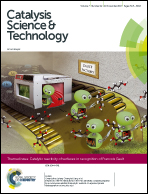Challenges and breakthroughs in post-combustion catalysis: how to match future stringent regulations
Abstract
This short overview briefly summarizes the prominent evolutions and scientific breakthroughs in the development of end-of-pipe technologies with respect to the standard regulations of atmospheric pollutant emissions from automotive exhaust. Up to now, several strategies have been implemented to fulfill more and more stringent emission limits and to overcome the extensive use of critical materials. This led to the elaboration of cheaper and more compact systems with close-coupled technologies suitable for light duty vehicles and also to preserve the competitiveness of car manufacturers. But all these improvements could not be sufficient to face short-term, more severe limitations as well as more realistic test driving cycles since the actual ones usually underestimate the emissions of current atmospheric pollutants especially from diesel powered engines. Presently, several scenarios have been envisioned which account for the partial replacement of liquid fossil fuels by alternative fuels for urban travel and the emergence of hybrid engines powered by natural gas or bio-fuels accompanied by more simple and efficient end-of-pipe systems. In this short overview, particular attention was paid to the past and present academic contributions which led and/or inspired important technical and commercial applications.

- This article is part of the themed collections: 2017 Catalysis Science & Technology HOT Articles and Catalytic reactivity of surfaces: in recognition of François Gault


 Please wait while we load your content...
Please wait while we load your content...